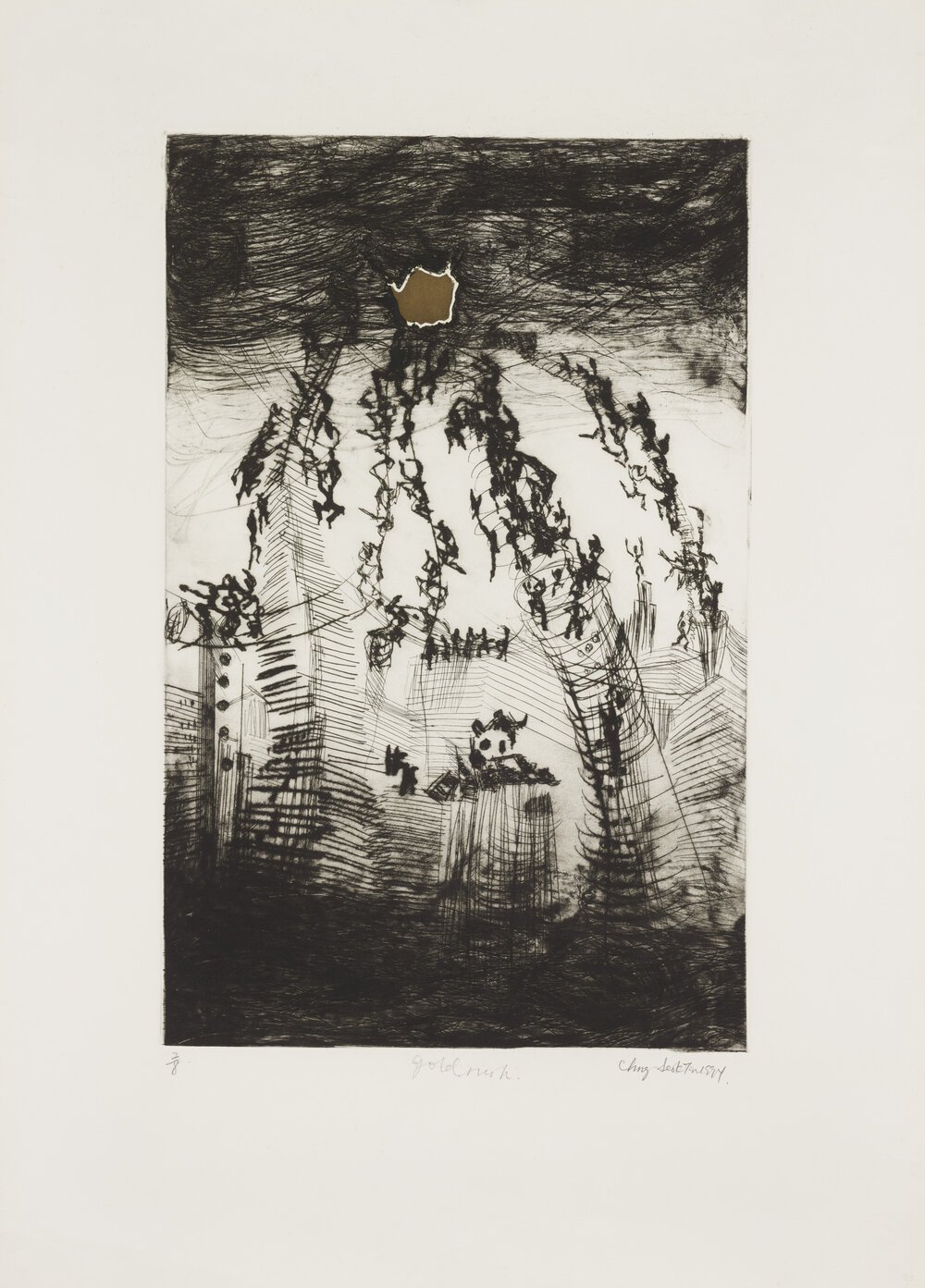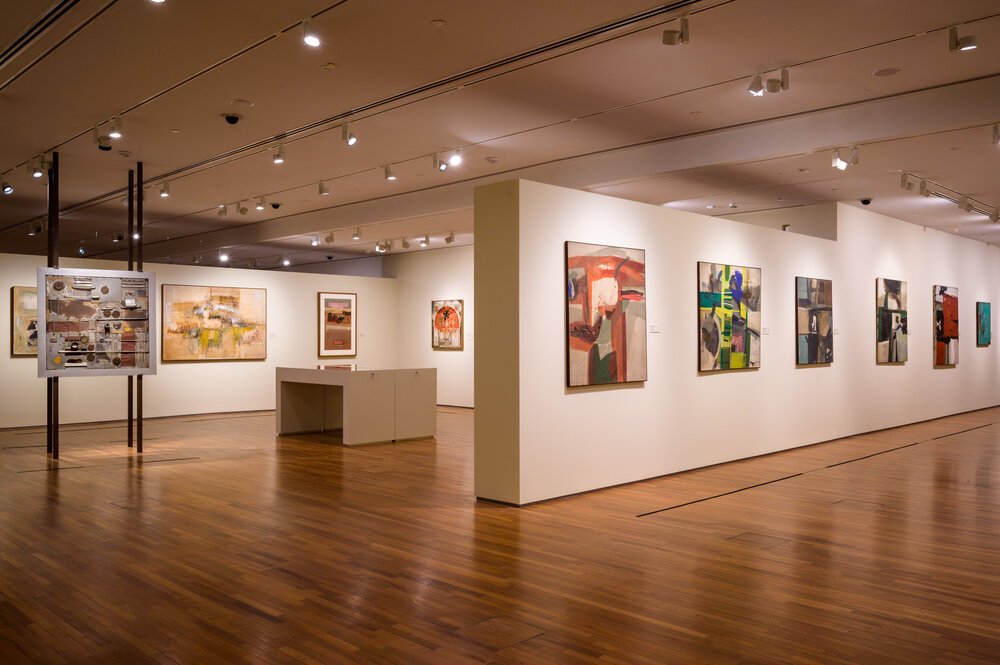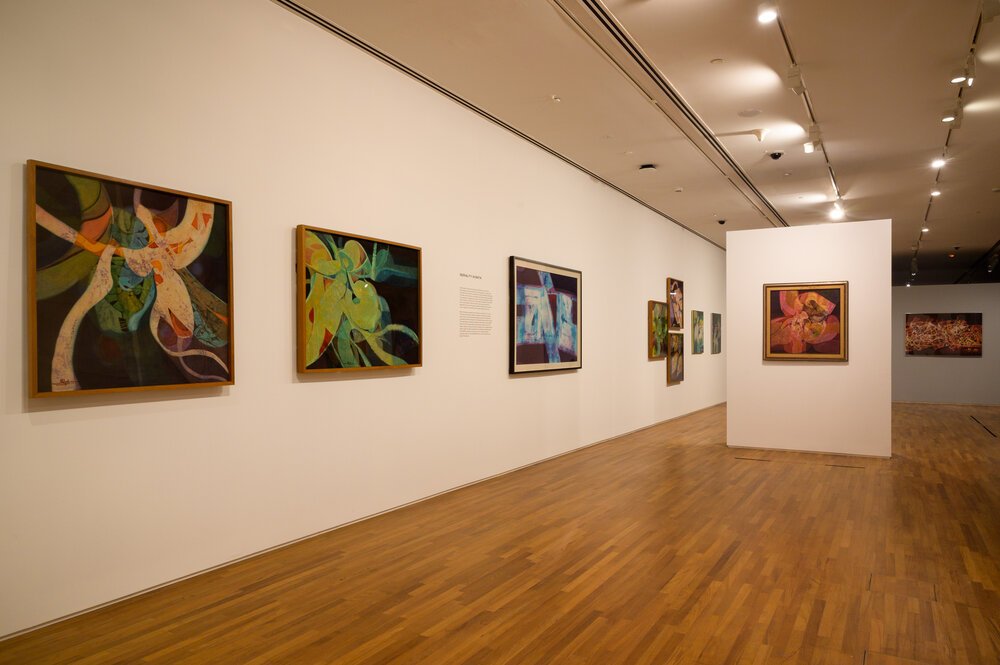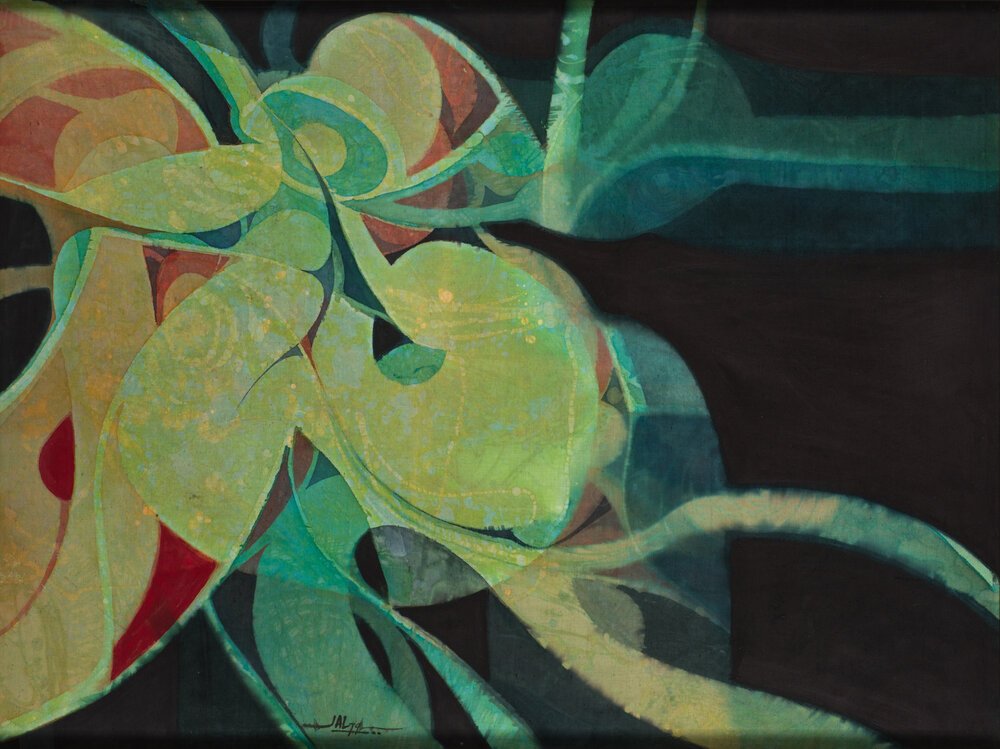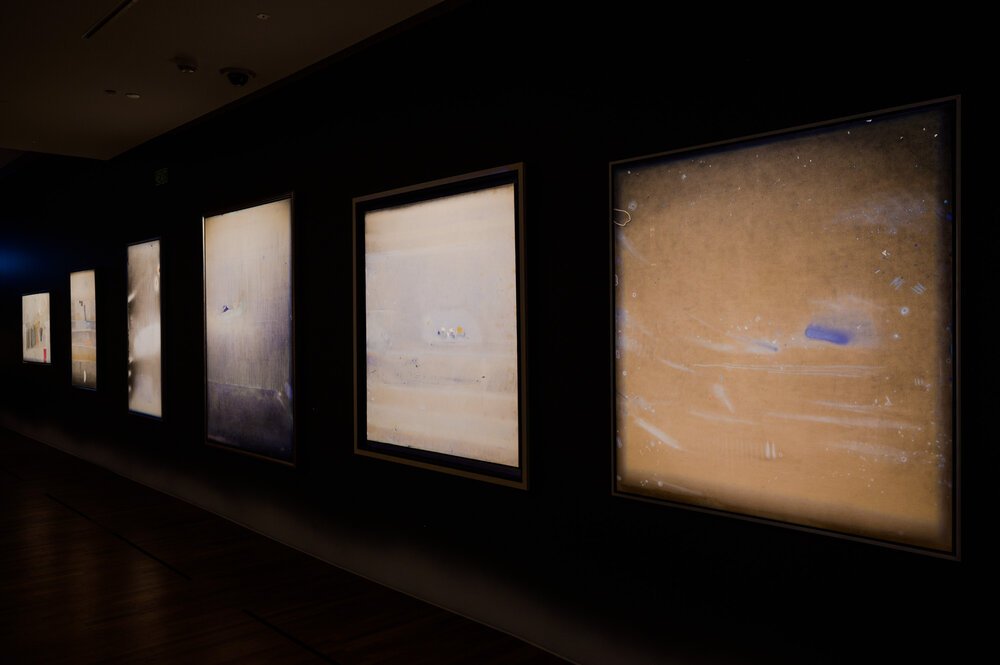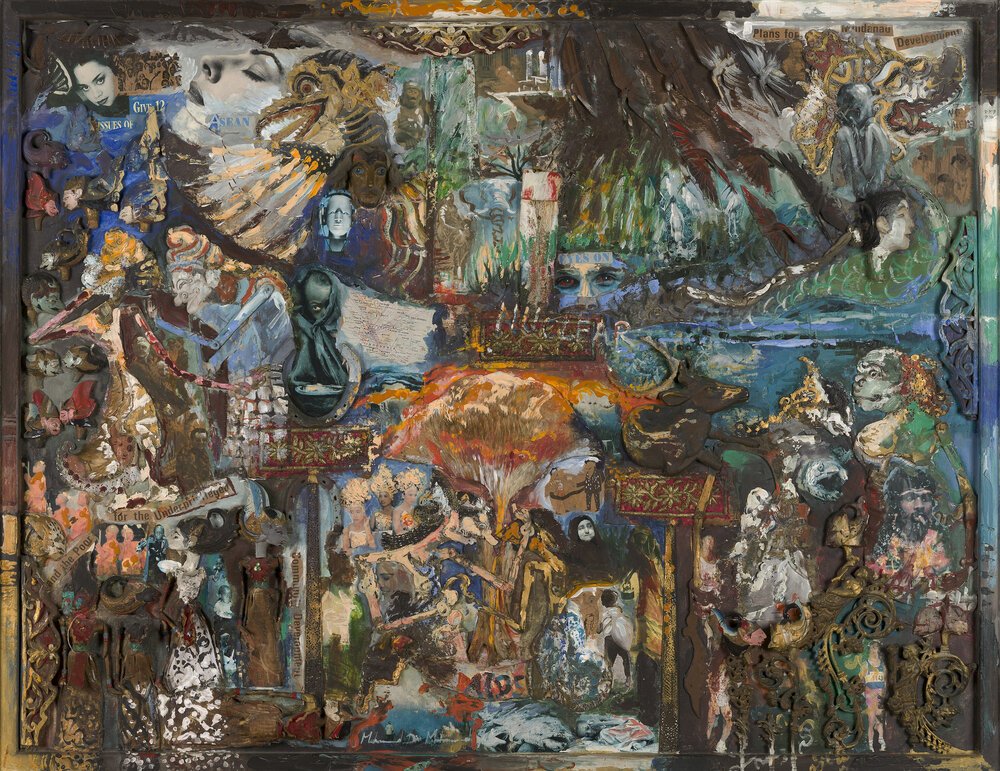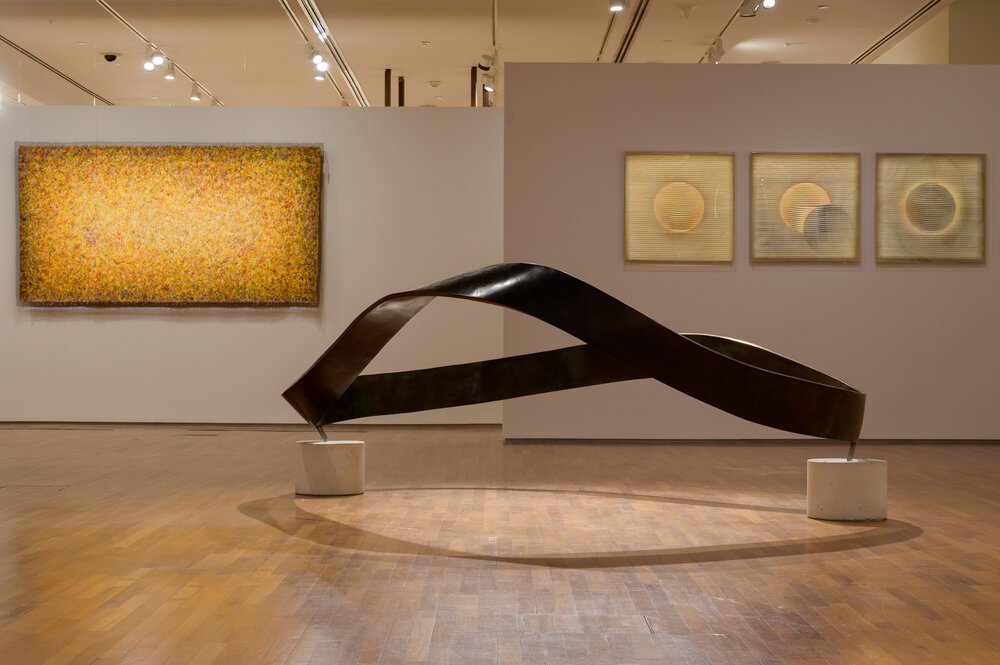‘Something New Must Turn Up’ at NGS
Singaporean Artists Chng Seok Tin, Goh Beng Kwan, Jaafar Latiff, Lin Hsin Hsin, Mohammad Din Mohammad and Eng Tow
By Ian Tee and Vivyan Yeo
The sprawling exhibition ‘Something New Must Turn Up: Six Singaporean Artists After 1965’ at the National Gallery Singapore, led by curator Seng Yu Jin, features the work of Chng Seok Tin (莊心珍), Goh Beng Kwan (吴珉权), Jaafar Latiff, Lin Hsin Hsin (林欣欣), Mohammad Din Mohammad (محمد دین محمد) and Eng Tow (杜瑛). A&M has prepared a profile article on the artists as an introduction to their practices and representative works. Before it closes on 22 August 2021, be sure to plan a visit to find out more about their experimental practices through 300 artworks and more than 100 archival materials and objects.
‘Chng Seok Tin: Drawn Through a Press’, 2021, exhibition view at National Gallery Singapore as part of ‘Something New Must Turn Up: Six Singaporean Artists After 1965’. Image courtesy of National Gallery Singapore.
Chng Seok Tin, ‘Gold Rush’, 1993, drypoint on paper, 64.8 x 35.4cm. Collection of Singapore Art Museum.
Chng Seok Tin: Drawn Through a Press
One cannot discuss modern printmaking in Singapore without acknowledging Chng Seok Tin’s (1946-2019) pivotal place in it. She attended the Nanyang Academy of Fine Arts (NAFA) in 1970 and later received an award from the Ministry of Culture to study advanced printmaking in the United Kingdom, France and United States. After returning to Singapore, Chng spearheaded the printmaking department at LASALLE College of the Arts from 1986 to 1995, introducing innovative approaches to the medium.
‘Drawn Through a Press’ showcases the breadth of Chng’s practice, which encompassed printmaking, drawing, collage, sculpture and installation. The presentation begins with lyrical works on paper that captured picturesque landscapes from her travels in the 1970s and early 1980s. Despite losing 90% of her vision in an accident in 1988, Chng not only continued to find ways of expressing environmental and social concerns in her work, but even forayed into three-dimensional space with sculptural and installation pieces. ‘Gold Rush’ (1993) is a striking example of how Chng adapted her printmaking practice by focusing on techniques such as drypoint that prioritised the sense of touch rather than sight. It depicts hordes of figures frantically reaching for a patch of gold in the sky, speaking to people’s anxieties about climbing the social ladder.
Chng was also a prolific writer who regularly contributed to local Chinese newspapers and published 13 volumes of writing during her lifetime. The topics discussed go beyond artistic discourse, and included her experiences abroad, her commentary on society and encounters with individuals. Chng summed up the relationship between art-making and writing best in a reflection penned on 19 August 2009, “with my two brushes – one for painting and the other for writing – I will share with everyone my innermost thoughts and feelings.”
‘Goh Beng Kwan: Nervous City’, 2021, exhibition view at National Gallery Singapore as part of ‘Something New Must Turn Up: Six Singaporean Artists After 1965’. Image courtesy of National Gallery Singapore.
Goh Beng Kwan, ‘Tea Merchant 茶商’,c. 1980s, Chinese tea-wrapping paper, tea labels, rice paper, household paint, rust wash, ink and glue on paper, 108.5 x 78.7 cm. Gift of DBS Bank Ltd. Collection of National Gallery Singapore. Image courtesy of the artist.
Goh Beng Kwan: Nervous City
Curator Joleen Loh describes Goh Beng Kwan’s process (1937-) as “working through collage through the idiom of painting”. The artist is best known for his experimental collage-paintings that embrace a diverse range of materials, from rice paper to tea-packing papers, and rags to scrap metal. Goh first studied under Cheong Soo Peng and Chen Wen Hsi during the 1950s, developing a strong foundation in painting and drawing. Later, he was one of the first post-war Singapore artists to receive training overseas, moving to New York to further his education at the Art Students League.
‘Goh Beng Kwan: Nervous City’ is an opportunity to view significant works , such as early oil paintings that evince the influence of Abstract Expressionism during his time in the United States, as well as his little-known metal assemblages. The presentation frames his work through the lens of the city. Goh’s ‘Urban Renewal’ series responds to Singapore’s rapidly developing cityscape in the mid-1960s. In his ‘Tea Merchant’ series, Goh embraced the formal qualities of rice paper and tea packaging to create bold, sparse compositions. Its minimal palette is a striking departure from the chromatic exuberance usually seen in his painting and mixed media works. Taken together, Goh’s oeuvre reflects his interpretation of multiculturalism and his engagement with an international dialogue on abstraction.
‘Jaafar Latiff: In the Time of Textile’, 2021, exhibition view at National Gallery Singapore as part of ‘Something New Must Turn Up: Six Singaporean Artists After 1965’. Image courtesy of National Gallery Singapore.
Jaafar Latiff, ‘Wandering Series 8/79’, 1979, batik, 90 × 120 cm. Gift of the artist. Collection of National Gallery Singapore.
Jaafar Latiff: In the Time of Textile
Jaafar Latiff (1937-2007) was a self-taught artist who ventured into new ground with his use of the batik medium. In parallel to Eng’s experience in the Bauhaus school, he was a teacher of Applied Arts at the Baharuddin Vocational Institute (BVI), which focused on craftsmanship and design. Challenging ideas of batik at the time, he experimented with industrial chemical dyes instead of using organic dyes, which tend to fade over time. While maintaining the use of the traditional wax-resist technique, he also combined batik with an expressive, gestural abstract style, further expanding the scope of painting in this medium. Throughout his life, Latiff was unafraid to explore other mediums such as acrylic paint and digital art, which offered alternative ways of composing images.
‘Jaafar Latiff: In the Time of Textile’ spotlights three series of batik paintings by Jaafar Latiff developed between the mid-1970s and the early 1990s: ‘Wandering’, ‘Batik 87/88’ and ‘Self-Portrait’. In particular, ‘Wandering’ was the first batik series that Jaafar Latiff embarked on after returning from a study trip to Nagoya, Japan. Works such as ‘Wandering Series 8/79’ (1979) are characterised by dark backgrounds and flowing organic shapes. Multiple layers of dye overlap to form vibrant colours and intricate structures. The series’ strong sense of movement, combined with the laborious process of batik painting, showcases the artist’s profound balance of control and spontaneity.
‘Lin Hsin Hsin @Speed of Thought’, 2021, exhibition view at National Gallery Singapore as part of ‘Something New Must Turn Up: Six Singaporean Artists After 1965’. Image courtesy of National Gallery Singapore.
Lin Hsin Hsin, ‘Conversation’, from ‘Man and His Universe’ series, 1982, oil on canvas with mixed media, 128 x 88cm. Collection of National Gallery Singapore. Copyright © 2021. Lin Hsin Hsin. All Rights Reserved. Mobile~tainment®, Frog®. https://lhham.com.sg/man/conversation1.html.
Lin Hsin Hsin @Speed of Thought
Trained in mathematics, computer science, music and fine art, Lin Hsin Hsin is an interdisciplinary artist who channels the power of technology in her practice. Before fully immersing herself into the digital world, she studied painting under Nanyang artists such as Cheong Soo Pieng. ‘@Speed of Thought’ foregrounds Lin’s paintings, paper sculptures, poetry, music compositions and digital artworks created from the 1970s to the present. While her early work utilised traditional mediums such as oil paint and paper, her later works involve imaging techniques produced through algorithms she developed. Her championing of technology echoed Singapore’s promotion of computerisation during the 1980s in efforts to sustain the country’s economic growth.
Lin composed a series of paintings titled ‘Man and His Universe’ (1982) that reflects on the complexity of the solar system. Among them is ‘Conversation’, which features cell-like shapes confined within an irregular box. With torn jute adhered onto the canvas, the painting adopts a heavily textured surface hinting at the unpredictable terrain of the cosmos. Her manipulation of oil paint gives rise to a translucent and otherworldly background; the cell-like structures appear to float within a system that mankind has yet to understand.
‘Mohammad Din Mohammad: The Mistaken Ancestor’, 2021, exhibition view at National Gallery Singapore as part of ‘Something New Must Turn Up: Six Singaporean Artists After 1965’. Image courtesy of National Gallery Singapore.
Mohammad Din Mohammad, ‘Issues and Emotions’, 1995, magazine and newspaper cutouts, wayang golek, wayang kulit, silat belts, horseshoes, animal hide, talismans, woodcarvings, and acrylic and ink on board, 105 x 137cm. Private collection.
Mohammad Din Mohammad: The Mistaken Ancestor
For Mohammad Din Mohammad (1955-2007), art was not only an aesthetic practice, but also a spiritual one. The Malacca-born artist was a Sufi mystic, traditional healer, silat guru, writer and collector of artefacts from all over Southeast Asia. After graduating from the Nanyang Academy of Fine Arts in Singapore in 1976, he worked as a street painter along Bugis Street. He then had a motorcycle accident in 1982, from which he recovered under the care of his silat masters. This experience sparked his journey towards traditional healing, which intertwined with his artistic endeavours.
As a Sufi mystic, Mohammad Din Mohammad believed that every aspect of the world is interconnected. ‘The Mistaken Ancestor’ expresses his all-encompassing approach through the display of his personal archives and extensive collection of artefacts, which includes Malay medicinal manuscripts, keris, shadow puppets and many more.
Oftentimes, his artworks were deployed as tools to address the social and economic anxieties of life. In the wall assemblage ‘Issues and Emotions’ (2000), we observe an amalgamation of figures and referents drawn from the deep myths and history of Southeast Asia to contemporary representations of the region throughout the work. In between, there are snippets of paper cuttings and headlines and printed text clipped from newspapers and magazines of words, with strong political and social associations such as ‘ASEAN’, ‘Nuclear’, ‘Underprivileged’, ‘Community Development’, and ‘AIDS’. The array of visual elements overlap one another to form a dense composition. As our eyes wander restlessly around the work, we are challenged to find connections between global socio-political issues and minute details of everyday life.
‘Eng Tow -- The Sixth Sense’, 2021, exhibition view at National Gallery Singapore as part of ‘Something New Must Turn Up: Six Singaporean Artists After 1965’. Image courtesy of National Gallery Singapore.
Eng Tow, ‘Eclipse’, 1983, triptych on spray-dyed acrylic on stitched cloth relief, 72 x 226 cm. Collection of Tang Wee Sung.
Eng Tow — The Sixth Sense
Like Chng, Eng Tow (1947-) first studied at NAFA before pursuing further opportunities overseas. After graduating with a Masters of Art from the Royal College of Art in London in 1974, she worked as a freelance textile designer for several years. Eng relocated to Singapore in 1981 and continued to design interiors, products and stage sets, while regularly exhibiting alongside her contemporaries. She made a name with ground-breaking cloth works that challenged traditional notions of painting and craft.
‘Eclipse’ (1983) is a mature example of Eng’s cloth relief work. It features three meticulous pleated panels that the artist sprayed with gentle gradations of dye. This sensitivity to material and surface is evident throughout Eng’s creative output, in her hand-cast paper works that began in the 1980s and later in her bronze sculptures. The viewer is called to slow down to appreciate subtle shifts in tone and the intensity in making these objects.
Goh and Eng are associated with the influential Alpha Gallery, Singapore’s first artist-cooperative. It was not only one of the few venues championing contemporary art during its time but was also where artists mingled with poets, architects and cultural policy-makers, and the boundaries between disciplines were fluid.
‘Something New Must Turn Up: Six Singaporean Artists After 1965’ is on show at National Gallery Singapore from 7 May to 22 August 2021. For more information, visit nationalgallery.sg/somethingnewmustturnup.
To learn further about each artist, we recommend the individual catalogues that curators Cheng Jia Yun (for Chng Seok Tin); Goh Sze Ying (for Jaafar Latiff); Lim Shujuan (for Eng Tow); Joleen Loh (for Goh Beng Kwan); Shabbir Hussain Mustafa and Teo Hui Min (for Mohammad Din Mohammad) have put together in accompaniment to the exhibition. They can be purchased at The Gallery Store by ABRY at National Gallery Singapore or at Select Books.


